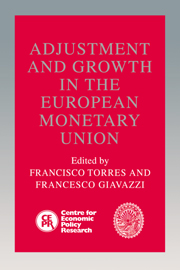Book contents
- Frontmatter
- Contents
- List of figures
- List of tables
- Preface
- List of contributors
- Foreword
- 1 Introduction
- 2 Economic and monetary union: critical notes on the Maastricht Treaty revisions
- Discussion
- 3 The design of optimal fiscal rules for Europe after 1992
- Discussion
- 4 Contracts, credibility and common knowledge: their influence on inflation convergence
- Discussion
- 5 Inflation in fixed exchange regimes: the recent Portuguese experience
- Discussion
- 6 Models of economic integration and localized growth
- Discussion
- 7 Shocking aspects of European monetary integration
- Discussion
- 8 Lessons of Massachusetts for EMU
- Discussion
- 9 Financial and currency integration in the European monetary system: the statistical record
- Discussion
- 10 Currency substitution: from the policy questions to the theory and back
- Discussion
- 11 Coordination of capital income taxes in the economic and monetary union: what needs to be done?
- Discussion
- Index
7 - Shocking aspects of European monetary integration
Published online by Cambridge University Press: 29 January 2010
- Frontmatter
- Contents
- List of figures
- List of tables
- Preface
- List of contributors
- Foreword
- 1 Introduction
- 2 Economic and monetary union: critical notes on the Maastricht Treaty revisions
- Discussion
- 3 The design of optimal fiscal rules for Europe after 1992
- Discussion
- 4 Contracts, credibility and common knowledge: their influence on inflation convergence
- Discussion
- 5 Inflation in fixed exchange regimes: the recent Portuguese experience
- Discussion
- 6 Models of economic integration and localized growth
- Discussion
- 7 Shocking aspects of European monetary integration
- Discussion
- 8 Lessons of Massachusetts for EMU
- Discussion
- 9 Financial and currency integration in the European monetary system: the statistical record
- Discussion
- 10 Currency substitution: from the policy questions to the theory and back
- Discussion
- 11 Coordination of capital income taxes in the economic and monetary union: what needs to be done?
- Discussion
- Index
Summary
Introduction
From all appearances the process of European monetary unification continues to gather momentum. Nearly four years have passed since the last significant realignment of exchange rates of members within the European monetary system (EMS). All significant controls on capital movements among member countries have been removed. Discussions of the establishment of a European central bank and a single currency are proceeding apace. If the current timetable is observed the transition will have been completed by the end of the decade.
At the same time there remain serious questions about the advisability of a European Monetary Union (EMU) voiced, in the most recent round of discussions, by the governments of the United Kingdom and Spain. By definition, EMU involves a sacrifice of monetary autonomy. In response to country-specific shocks, governments will no longer have the option of adopting a monetary policy which differs from that of the union as a whole. Insofar as monetary policy is useful for facilitating adjustment to disturbances, adjustment problems may grow more persistent and difficult to resolve.
These concerns are reinforced to the extent that it is believed that completion of the internal market will place new limits on the use of fiscal policy. Not only will individual governments have lost autonomy over the use of seigniorage to finance budget deficits but, insofar as the 1992 process renders factors of production increasingly mobile, constraints will be placed on their ability to impose tax rates significantly different from those of their neighbours.
- Type
- Chapter
- Information
- Adjustment and Growth in the European Monetary Union , pp. 193 - 235Publisher: Cambridge University PressPrint publication year: 1993
- 202
- Cited by

